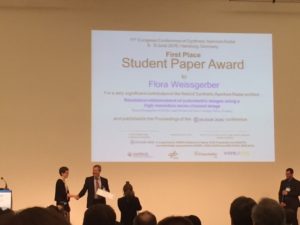My article entitled “Resolution enhancement of polarimetric images using a high resolution mono-channel image” won the first prize of the EuSAR 2016 Student Award. The work presented in this article was the extension of the work I presented in POLinSAR 2015.
This article deals with the main goal of my PhD which is the merge of high resolution single-pol image and quad-pol images acquired with the same sensor in interferometric condition in order to produce high resolution quad-pol image. The polarimetric features of the scatterers have to be preserved as well as the interferometric capacity of the initial quad-pol image. Our goal is thus to preserve the power of the polarimetric channel but also its phase. A spectral approach based on the spectral properties of white and isotropic point-like scatterers has been chosen. The pixels of the images are thus modeled as the sum of the point-spread fonction of point-like scatterers, which can be approximated as a cardinal sine in both direction, and a fully developed speckle, dominating in homogeneous areas.
In this article, two spectral algorithms are presented. The first one, called the sum method reconstruct better the point-like scatters but correlated the polarimetric channel in homogeneous areas. On the other hand, the algorithm called the center-point method preserves better the speckle properties. These two algorithms are merged, based on a point-like scatterers and bright lines detection.
The results are illustrated on images acquired over Salon de Provence by ONERA’s SETHI sensor and images acquired over Amsterdam by TerraSAR-X. In order to process these real data, preprocessing such as the spectrum unwrapping and unweighting are also needed. These preprocessings are implemented in order to deal with data acquired by different sensors with various resolution ratios.
The final processing chain is a versatile tool to create high resolution polarimetric images from polarimetric images and a high resolution mono-channel images.

